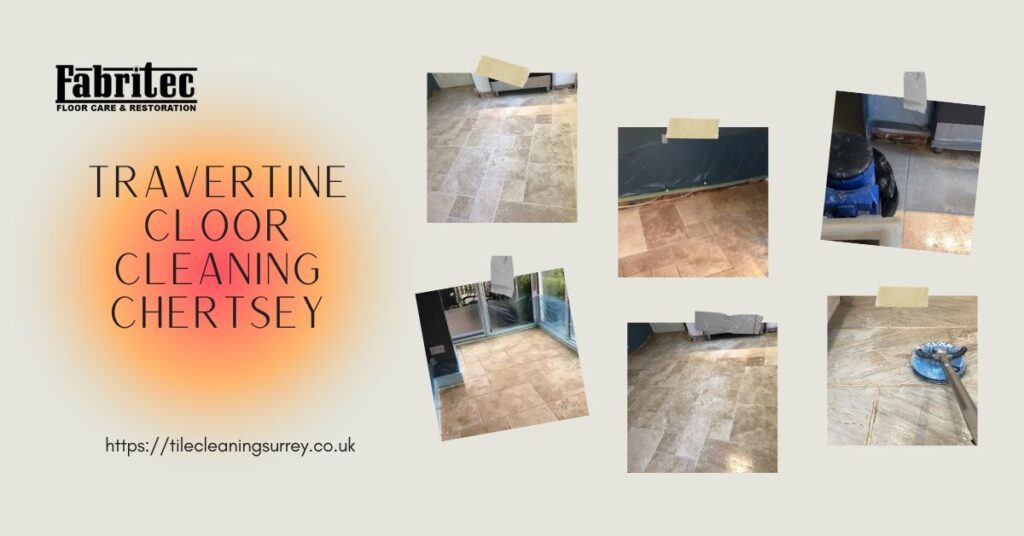
Background
Travertine floors are known for their natural beauty and unique appearance, but they require proper care and maintenance to maintain their charm over time. Recently, we had the opportunity to revitalise a well-worn travertine floor in a residential property in Chertsey, Surrey. This case study will illustrate the steps we followed to clean, repair, and seal the travertine floor, ensuring it not only looked new but also would last for years to come.
Initial Assessment and Preparation
Upon initial inspection, the travertine floor showed signs of wear, including visible dirt buildup in the grout lines, small natural holes typical of travertine stone, and some minor cracks in a few tiles. To ensure a clear workspace, we removed all furniture from the area before vacuuming up any loose debris and dust.
To protect surrounding surfaces, such as kitchen units and adjacent floors, we applied protective sheeting. This is critical in preventing any potential damage from cleaning agents or equipment during the cleaning process.
Deep Cleaning the Travertine Tiles and Grout
The key to revitalising travertine is a thorough, deep cleaning process. We started by applying a diluted, professional-grade travertine cleaner across the floor, paying special attention to grout lines and any heavily soiled areas. After allowing the cleaner to sit for about ten minutes to loosen embedded dirt, we used a rotary scrubbing machine to work the cleaner into the tiles.
This method effectively lifted the grime that had accumulated over time, leaving the surface visibly cleaner. To ensure the floor was completely clean, we followed up with pressure rinsing, a crucial step for removing any remaining cleaning slurry and debris. The rinse also eliminated any residues from previous sealers, preparing the surface for repair and sealing.
Repairing the Travertine Tiles
Upon cleaning, we discovered a few natural holes and minor cracks in the travertine tiles, common in this type of stone. To address these issues:
Filling Holes:
We filled the natural holes using high-quality beige fillers that blended well with the existing tile colour. This step not only restored the uniformity of the floor but also prevented future dirt buildup in these crevices.
Repairing Cracks
For the cracked tiles, we used a resin grout that allows for slight movement without causing additional cracks. Colour-matching the grout to the tile ensured that the repairs were almost invisible, maintaining the floor’s seamless aesthetic.
Sealing the Travertine Floor
The final, yet most critical, step in this process was sealing the travertine floor. Sealing protects the stone from stains, spills, and everyday wear and tear, thus extending the floor's life. For this project, we applied a high-solids, breathable sealer that not only penetrated the travertine but also formed a protective barrier on the surface.
Our client preferred a satin finish, which enhanced the natural beauty of the travertine without making it overly glossy. After the sealer was applied, we allowed it to cure for several hours, ensuring the floor was ready for regular use.
Aftercare Recommendations
To maintain the travertine's refreshed appearance, we advised the client to follow a regular cleaning routine:
- Use a pH-neutral cleaner specifically designed for sealed natural stone, such as LTP Floorshine, to avoid damaging the sealer.
- Regularly vacuum or dust the floor to prevent dirt from scratching the surface.
- Immediately clean up any spills to prevent staining.
- Reapply the sealer every 2 to 3 years, depending on foot traffic, to maintain the floor's protection and appearance.
Outcome
After completing the cleaning, repairing, and sealing processes, the travertine floor in the Chertsey property was transformed. The floor now had a renewed lustre, the grout lines were clean, and the repaired cracks were barely noticeable. The client was delighted with the results, and the floor was protected against future damage, ensuring it would remain beautiful for years to come.
We couldn’t be happier with the results! Our travertine floor looks absolutely stunning—like it’s brand new again. The team was professional, thorough, and took great care to restore every detail. We’re thrilled with how well the repairs blend in, and the sealing has made cleaning so much easier. Highly recommend their service!
This project highlights the importance of regular professional maintenance for travertine flooring to preserve both its aesthetic appeal and functional longevity.
Frequently Asked Questions
How Often Should I Clean My Travertine Tiles?
Cleaning travertine tiles should occur regularly, ideally once or twice a week, depending on foot traffic. Additionally, deep cleaning every six months guarantees the maintenance of their aesthetic appeal and longevity. Always use appropriate cleaners.
Can I Use Vinegar to Clean Travertine Surfaces?
Using vinegar to clean travertine surfaces is not advisable, as its acidity can damage the stone and its protective seal. Instead, opt for a pH-balanced cleaner specifically formulated for natural stone to maintain its integrity.
What Are Common Signs of Travertine Damage?
Common signs of travertine damage include visible cracks, chips, discoloration, and uneven surfaces. Additionally, persistent stains or dullness indicate wear, necessitating immediate attention to maintain both the aesthetics and structural integrity of the flooring.
Is Travertine Suitable for Outdoor Use?
Travertine is suitable for outdoor use due to its durability and natural slip resistance. However, proper sealing is essential to protect it from weathering and staining, ensuring longevity and maintaining its aesthetic appeal in outdoor environments.
How Can I Prevent Future Staining on Travertine?
To prevent future staining on travertine, apply a high-quality sealer regularly, promptly clean spills, and utilise pH-neutral cleaners. Additionally, maintain a consistent cleaning routine to enhance the stone's durability and aesthetic appeal.
The post: Travertine Cleaning Chertsey was produced by Travertine Floor Cleaning Chertsey
The Article Cleaning and Sealing a Travertine Floor in Chertsey, Surrey appeared first on https://fabritec.org
The Article Cleaning and Sealing a Travertine Floor in Chertsey, Surrey Was Found On https://limitsofstrategy.com


I really appreciate the insights you’ve shared about the process of revitalizing travertine floors. It’s fascinating to think about how something so beautiful in its natural state can still require a focused approach to maintain its splendor over time. I find it interesting that travertine, with its unique formations and textures, offers both challenges and rewards when it comes to care.
It’s great to hear you found the insights about revitalizing travertine floors so captivating. There really is a unique relationship between natural materials and their upkeep, isn’t there? Travertine does have this exquisite charm with its earthy tones and those distinct textures, but it does require a certain level of commitment to keep it looking its best over the years.
I completely agree with you about the relationship between natural materials and their upkeep. It’s fascinating how the way we care for things like travertine can reflect our values around sustainability and nurturing the environment. The earthy tones really do create such a warm and inviting atmosphere; I often find myself drawn to spaces that incorporate such organic elements.
You’re hitting the nail on the head with that one. The way we care for materials like travertine really does speak volumes about our priorities. It’s like those fancy social media influencers we can’t escape, constantly reminding us how to curate our lives. But hey, instead of posing with a smoothie bowl on the latest filter, we’re nurturing our homes in ways that echo our love for nature.
It’s great to hear your thoughts on the connection between natural materials and our values. The way we engage with materials like travertine not only reflects our appreciation for beauty but also emphasizes a deeper relationship with our surroundings. When we choose to incorporate these earthy tones, we create spaces that feel alive, grounded, and authentic.
It’s great to hear you found the insights useful. Travertine really does have that unique blend of beauty and complexity, doesn’t it? The textures and patterns can tell such a story, but they also need a bit of TLC to keep looking their best.
I completely agree with you about the beauty and complexity of travertine. It’s fascinating how natural materials like that can reflect so much history and artistry. I remember visiting a historical site once that used travertine, and the way light interacted with the stone really brought the architecture to life.
I completely agree. The depth of travertine can really transform a space, and it’s fascinating how each piece has its own narrative etched into it. I’ve noticed that the way it interacts with light can change throughout the day, almost like it’s alive in its own way.
You’re spot on about travertine’s unique qualities. Each slab does tell its own story, shaped over centuries by natural processes. The way it catches light can create a completely different atmosphere at various times of the day—it’s almost therapeutic to watch. It’s interesting to think about how those subtleties can shift the mood in a space; a warm glow in the morning versus a cooler tone in the evening can dramatically change how we experience our environment. Have you found particular colors or patterns in travertine that resonate with you more?
Absolutely! If you’re intrigued by the unique beauty of travertine, check out this collection to see how it can elevate your space even further.
https://mannland5.com/octopus
It’s great to hear that the insights resonated with you. The balance between the natural beauty of travertine and the attention it requires is definitely intriguing. One aspect worth considering is how the environment where the travertine is installed can significantly affect its upkeep. For example, floors in high-traffic areas may show wear more quickly and require more frequent maintenance compared to those in quieter spaces.
Thank you for your thoughtful comment! If you’re interested in exploring more detailed tips and techniques for maintaining the beauty of travertine floors, check out this helpful guide.
https://mannland5.com/octopus
What a fascinating glimpse into the world of travertine floor revival! It’s like witnessing a beauty makeover, but instead of a radiant smile and a new wardrobe, we’re treated to the glimmering glow of natural stone. I’ve always found it interesting how a floor can carry so many stories, both in its wear and its character. It’s almost like the floor has lived a life of its own, complete with its own set of scars and tales of family gatherings, spilled grape juice casualties, and perhaps some impromptu dance-offs on particularly lively Saturdays.